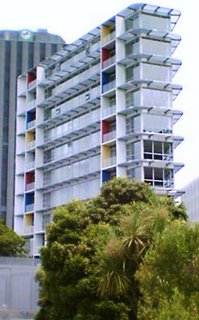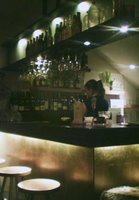A WellUrban year
 I've been writing WellUrban for just over a year now, though it feels like about ten. I originally intended this as an easier way to update my original wellurban.org.nz site about architecture and sustainable urban design, but I was inspired by those crazy kids over at the Wellingtonista to write more broadly about life in Wellington. Looking back at the first month of WellUrban, I can see that I was already writing about burlesque nights, graffiti and the "man drought" as well as Harbour Quays, wind farms and Futuna Chapel. While I've considered splitting the content into two separate blogs (one for serious urban design stuff and one for frivolous happenings-about-town), I've looked at the comments and realised that architects enjoy Martinis and barflies care about transport. What goes on in the city is just as important as the form it takes.
I've been writing WellUrban for just over a year now, though it feels like about ten. I originally intended this as an easier way to update my original wellurban.org.nz site about architecture and sustainable urban design, but I was inspired by those crazy kids over at the Wellingtonista to write more broadly about life in Wellington. Looking back at the first month of WellUrban, I can see that I was already writing about burlesque nights, graffiti and the "man drought" as well as Harbour Quays, wind farms and Futuna Chapel. While I've considered splitting the content into two separate blogs (one for serious urban design stuff and one for frivolous happenings-about-town), I've looked at the comments and realised that architects enjoy Martinis and barflies care about transport. What goes on in the city is just as important as the form it takes.One of the reasons that I promote urban life is that high-density cities are more sustainable than sprawling ones. The concentration of residents and workplaces makes walking and public transport more feasible, and apartments are easier to heat than stand-alone dwellings. That's one of the reasons why New York is the "greenest" city in America, and why Wellington has a relatively low ecological footprint per capita.
But just as importantly, dense cities are more fun! Wellington may be only a small city, but its CBD has more workers than Auckland's, which goes some way towards explaining why we have so many bars, restaurants and cafés per capita. And it looks like as the inner-city population grows, our hospitality scene will continue to thrive.
 While there are all these benefits to compact cities, increasing the population of the inner city has to be carefully managed: probably much more so than it is at the moment. Some of the new apartment buildings and conversions are very good, but many don't even aspire to mediocrity, and there are some burgeoning neighbourhoods that lack any sort of quality public spaces. That's why I've been trying to highlight good examples of high-density residential architecture, as well as promoting reclaiming public space from cars and the importance of complementing commercial development with proactive urban design. But if you're still worried about the densification of the city, consider the alternative. In the past ten years, 7,500 people have moved into Thorndon, Lambton and Te Aro. If they'd all moved into quarter-acre sections, they'd require at least 250ha of greenfield space: about the size of Karori Wildlife Sanctuary.
While there are all these benefits to compact cities, increasing the population of the inner city has to be carefully managed: probably much more so than it is at the moment. Some of the new apartment buildings and conversions are very good, but many don't even aspire to mediocrity, and there are some burgeoning neighbourhoods that lack any sort of quality public spaces. That's why I've been trying to highlight good examples of high-density residential architecture, as well as promoting reclaiming public space from cars and the importance of complementing commercial development with proactive urban design. But if you're still worried about the densification of the city, consider the alternative. In the past ten years, 7,500 people have moved into Thorndon, Lambton and Te Aro. If they'd all moved into quarter-acre sections, they'd require at least 250ha of greenfield space: about the size of Karori Wildlife Sanctuary. But instead, they're living in town, walking to work, and contributing to a lively urban culture that supports lots of independent shops, an energetic Arts Centre, experimental music venues, and at last count nearly 160 bars (of which I've managed to visit just over 75% this year). We have distinctive street art and street artists, and of course some great streets. We're all passionate about the waterfront, though of course not everyone can agree about what we want to see there. Some of the other controversial subjects on WellUrban have been transport (Light Rail? Busway? Trolleys? or Pods?), Harbour Quays, the Marine Education Centre and what happened to our coffee culture.
But instead, they're living in town, walking to work, and contributing to a lively urban culture that supports lots of independent shops, an energetic Arts Centre, experimental music venues, and at last count nearly 160 bars (of which I've managed to visit just over 75% this year). We have distinctive street art and street artists, and of course some great streets. We're all passionate about the waterfront, though of course not everyone can agree about what we want to see there. Some of the other controversial subjects on WellUrban have been transport (Light Rail? Busway? Trolleys? or Pods?), Harbour Quays, the Marine Education Centre and what happened to our coffee culture.In addition to my regular readers, I get a few referrals from Google, many of which are from people who must have been looking for something quite different. For instance, WellUrban is still ranked 16th on Google for the word "toyboys" (thanks to this notorious post), and I hold the dubious honour of hosting the top two results for the search "swingers Baku". Most of those visitors leave fairly quickly, but if you're looking for mystery bars, in-depth articles on urbanism, hospitality industry gossip, architecture competitions or exhausting ways to spend the weekend, then you've come to the right place.



3 Comments:
Are you sure that Auckland's inner city popualtion is smaller than Wellington's?
Jo: I'm really not sure what you're talking about (I'm lying, of course, since I read your posts).
Flyin_higher: not residential population, but office workers. Wikipedia has figures (presumably based upon the 2001 census) saying that Wellington has just slightly fewer than Auckland's CBD, but the report quoted by the anti-Harbour Quays crowd states that the Wellington CBD currently has 14% more office floor area than Auckland's. While office space doesn't necesarily correlate with office workers, our office vacancy levels are at record lows, so I imagine it's a reasonable assumption (we'll have to wait for 2006 census workplace figures before we're sure). In any case, our ratio of CBD working population to total regional population is much higher than Auckland's, which is a good indicator of our compactness.
Thanks for the reply tom. I had thought you meant residential population. However, i'm fairly sure that Auckland's CBD office space is higher than Wellington's. But this is probably not the main point- you are bang on in saying that the Wellington CBD has a higher office job share than the Auckland CBD in terms of its greater metro area.
Post a Comment
<< Home